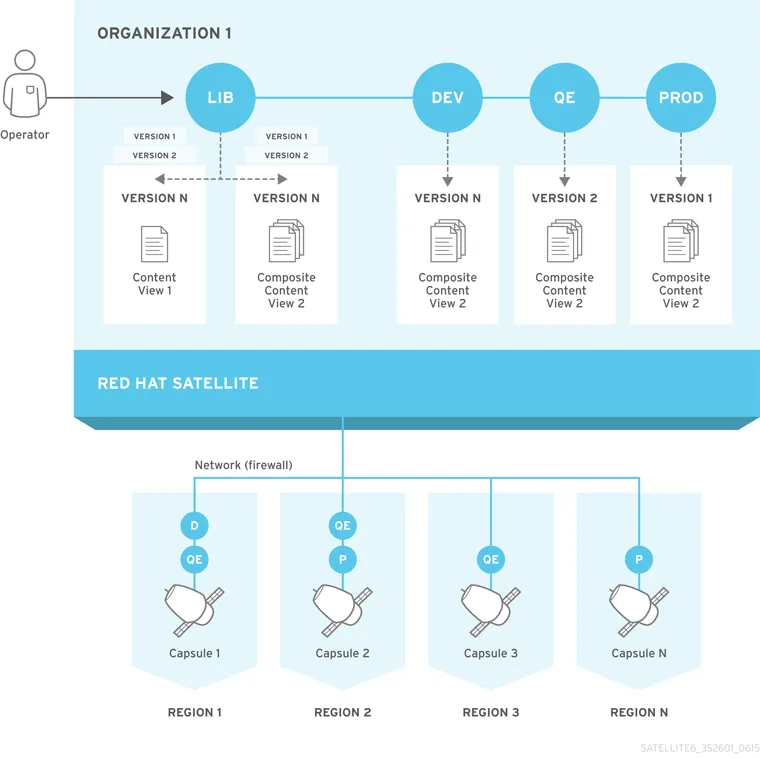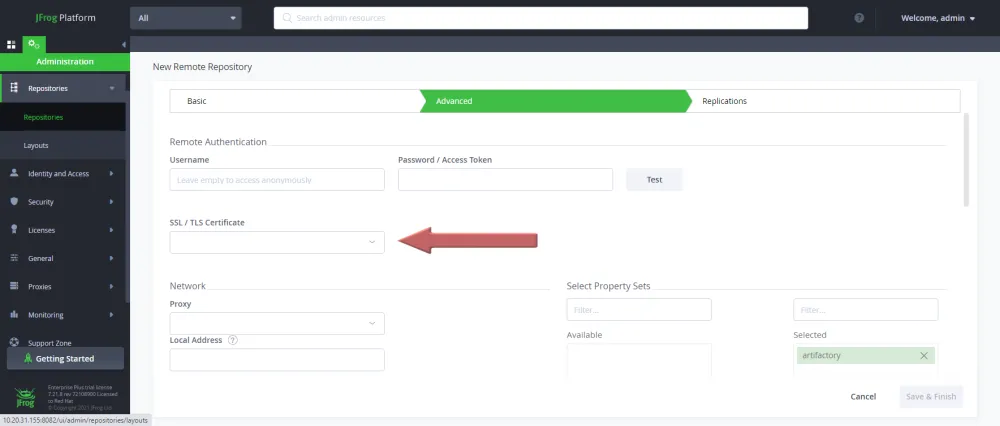Red Hat Satellite is a systems management solution that can help an organization deploy, configure and maintain systems across multi-cloud environments and on-premises environments. Satellite provisions, monitors and remotely manages Red Hat Enterprise Linux deployments in a single centralized tool.
JFrog Artifactory is a universal repository manager for binary life cycle management of artifacts, providing end-to-end management of artifacts throughout the software lifecycle process.
The purpose of this post is to show how Artifactory’s repository management helps organize and distribute Satellite’s life cycle management capabilities to downstream layers to keep Enterprise Linux systems running with consistent packages across the enterprise.
In Satellite, one could define a library of content from external sources for an Organization. Content views can be created as subsets of content from the Library. One can publish and promote content views into lifecycle environments - typically dev, QA and Production.
 In Artifactory, we need to define remote repositories mapping to each lifecycle environment. For example: Define an Artifactory remote repository called “dev-rpm-remote-dc” which corresponds to the dev lifecycle environment.
In Artifactory, we need to define remote repositories mapping to each lifecycle environment. For example: Define an Artifactory remote repository called “dev-rpm-remote-dc” which corresponds to the dev lifecycle environment.
Steps to combine Red Hat Satellite and JFrog Artifactory
Let's walk through the steps you need to follow to set this up. The post assumes you already have an up-to-date version of Red Hat Satellite and JFrog Artifactory. (The post is based around JFrog’s Artifactory version 7.21.)
Create an Organization Debug Certificate
To create a debug certificate for an organization, complete the following steps:
1. In the Satellite web UI, navigate to Administer > Organizations

2. Select an organization that you want to generate a debug certificate for
3. Click Generate and Download

4. Save the certificate file in a secure location
Gather the Satellite URL for the lifecycle environment you wish to add:
Procedure
Log into a system that is registered to the Satellite server and connected to the Lifecycle Environment you wish to add to Artifactory, and either manually assemble the URL or use the script below to retrieve the URLs.
Manual method:
1. Start with the URLs listed in /etc/yum.repos.d/redhat.repos
2. Replace $releasever with the value of: rpm -q --provides rpm -qf /etc/redhat-release | grep releasever
3. Replace $basearch with the value of: uname -i
Script:
You can run this script to automatically generate URLs for your lifecycle environment:
curl -s https://raw.githubusercontent.com/cshabazian/Get-Satellite-URLs/main/Get_Satellite_URLs.sh | bash
Add the Satellite Certificate to Artifactory:
Procedure
1. In the Artifactory web UI, navigate to SERVICES > Artifactory and select Certificates

2. Click + New Certificate

3. Give this certificate a recognizable alias such as Organization Satellite Certificate and drag and drop the certificate generated above into the Certificate box and click Save

Restart Artifactory server process for certificates to be trusted:
Procedure
1. Login to the Artifactory server and run as root:
systemctl restart artifactory
Add the repository to Artifactory:
Procedure
1. In the Artifactory web UI, navigate to Repositories > Repositories, click + Add Repositories, and select Remote Repository

2. In the Package Type dialog that pops up, select RPM

3. Select Advanced options and in SSL / TLS Certificate, select the certificate you loaded in the previous steps

4. Select Basic options, and in the URL box, paste the URL you previously gathered and click Test to ensure everything is setup correctly, Then click Save & Finish

Conclusion
In this post we’ve demonstrated how to define repositories in Artifactory as a backend to Satellite package distributions. We hope you’ll be able to take these basic steps and leverage them to do your own integrations between JFrog’s Artifactory version 7.21 and Red Hat Satellite version 6.x.
If you have questions about our proposed integration, or if you’re just getting started on your Red Hat and JFrog journey, find out more at JFrog.com or try Artifactory out for yourself on OpenShift.
Special thanks to Chip Shabazian, Red Hat Senior Platform Technical Account Manager, who made a major contribution to the writing of and technical review of this post, and the work to bring these products together to solve customer problems.
Über den Autor
Sudhindra Rao is seasoned technologist helping customers enabling them to transform how they build, deploy and run software. He has worked on a complete spectrum of technologies from mainframe to middleware to cloud and now DevOps. Rao is a leading Indian classical musician teaching Indian Percussion drum called Mridangam and lives in Raleigh, NC.
Ähnliche Einträge
F5 BIG-IP Virtual Edition is now validated for Red Hat OpenShift Virtualization
Eine Partner-Community statt vieler Einzelkämpfer
Transforming Your Identity Management | Code Comments
Bringing Deep Learning to Enterprise Applications | Code Comments
Nach Thema durchsuchen
Automatisierung
Das Neueste zum Thema IT-Automatisierung für Technologien, Teams und Umgebungen
Künstliche Intelligenz
Erfahren Sie das Neueste von den Plattformen, die es Kunden ermöglichen, KI-Workloads beliebig auszuführen
Open Hybrid Cloud
Erfahren Sie, wie wir eine flexiblere Zukunft mit Hybrid Clouds schaffen.
Sicherheit
Erfahren Sie, wie wir Risiken in verschiedenen Umgebungen und Technologien reduzieren
Edge Computing
Erfahren Sie das Neueste von den Plattformen, die die Operations am Edge vereinfachen
Infrastruktur
Erfahren Sie das Neueste von der weltweit führenden Linux-Plattform für Unternehmen
Anwendungen
Entdecken Sie unsere Lösungen für komplexe Herausforderungen bei Anwendungen
Virtualisierung
Erfahren Sie das Neueste über die Virtualisierung von Workloads in Cloud- oder On-Premise-Umgebungen
